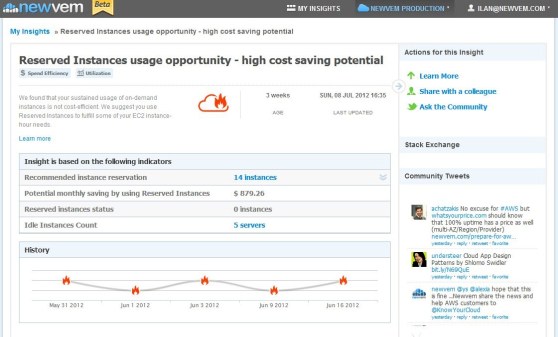 For certain things, the cloud is easier … someone else, after all, has to worry about your servers staying online. But for other purposes, such as determining optimum resource utilization, the cloud can be more difficult.
For certain things, the cloud is easier … someone else, after all, has to worry about your servers staying online. But for other purposes, such as determining optimum resource utilization, the cloud can be more difficult.
How hard are all those virtual servers actually working, after all?
Amazon dominates the cloud market with 60 percent market share, over 1 trillion data objects stored, and at least 450,000 servers in perhaps 7100 racks. And those servers don’t feed themselves electricity … ultimately someone is paying for all those server instances. How do you know you’re not paying too much?
The good news, if you’re a cloud user, is that cloud optimization specialists Newvem say they can save you money.
The company has just released a new Cloud Usage Analytics product that can potentially save companies thousands of dollars. In fact, over half of the companies they studied, up to 57 percent, would save money by switching to Amazon’s reserved instances.
“We analyze our clients’ clouds,” Newvem’s Cameron Peron told me. “And then we determine both their outage readiness and potential cloud savings.”
Reserve now, or pay as you go
It’s not as simple as just “moving to the cloud.” There are choices to be made … and they affect your costs.
One key choice is whether you buy cloud on demand or a la carte.
For on demand services, you make no commitments, but you pay extra for the privilege. For a la cart, you select reserved instances, which can save you between 35 and 50 percent. Reserved instances are like booking a no-refund airline ticket — you’re going to pay for that flight to Maui whether you’re on it or not. But … it’s cheaper than showing up at the airport and looking for a plane to get out of Dodge.
Amazon has been calling its enterprise customers and encouraging them to move them to reserved instances, Peron says. That gives Amazon revenue predictability, and locks in customers in the face of increasing cloud competition from Google, Microsoft, HP, and others.
So the question becomes …
As cloud clients consider the move to reserved instances, the question becomes: how many resources do we need? Savings beckon, but only if you can accurately predict demand.
“It’s a nightmare to figure that out,” says Peron. “We visually show our clients which parts of their cloud they should move from on-demand to reserved.”
At a very high level, that consists of analyzing cloud demand, identifying areas of consistent demand, and finding areas that fluctuate. Humans aren’t very good at this — up to 43 percent of reserved instances pre-purchased by even advanced users go unused, wasting millions of dollars.
So it’s a job for big data.
Newvem CEO Zev Laderman’s compares it to analyzing web logs manually versus using using an analysis too, saying that Newvem’s new product is “like Google Analytics for cloud computing.” Customer Charlie Schluting, an engineer at content monetization company Krux, agrees, saying that managing Reserved Instance manually “requires a lot of guesswork, calculations, and on-going auditing.”
Newvem scans your Amazon Web Services usage and determines what is being used, what is idle, and how companies can best execute a move. The company has already scanned almost 16,000 server instances for companies that use up to thousands of virtual servers, and found almost $6 million in potential savings.

Above: Reserved instances recommendation
The infographic
Newvem put together an infographic on Amazon’s cloud and potential savings:

photo credit: Werner Kunz via photo pin cc


